Bill Pierce, the famed, highly experienced photojournalist and Leica M photographer, has written of flying to the Eastern hemisphere from the US, and stopping in London on the way there. This made adjusting to the jet lag at the final destination a little bit easier. During his stopover, Mr. Pierce would drop by the Queen’s Fishery, to purchase a Brady fishing bag.
The Brady bag was a popular choice amongst world-travelling photojournalists at the time. This was before Billingham started making photo-specific bags in 1979. Brady fishing bags such as the Ariel Trout and Gelderburn were pressed into service as a long-lasting, tough bag that could take the abuse from photojournalists who travelled frequently into harrowing situations.
Yet the canvas was soft enough that it could conform and hug the photographer’s body. In addition, Brady’s Ariel Trout and Gelderburn bags have a form and shape similar to today’s popular messenger bags – wide and tall, but slim, front to back. Its lack of thickness made it easier to move around on crowded streets.

The Brady Gelderburn is a slim bag, easy to maneuver in crowds. Inside the main compartment when the photo was made, were 2 rangefinder form camera bodies & 5 lenses. The front pocket had a light meter
In addition to reading about Brady bags in Bill Pierce’s article, Over a decade ago, I also heard about it from Sal DiMarco Jr., an experienced Blackstar photojournalist and a regular contributor to TIME magazine. Mr. DiMarco was highly accomplished, and had multiple TIME front covers to his name.
Like Mr. Pierce, he too used Brady bags. Back in 2001 or 2002, I contacted Mr. DiMarco via e-mail for advice on which Brady bag to get. He very kindly advised me to choose the Gelderburn model, and taught me how to pack it properly. I was quite amazed at how helpful he was to a total stranger like me, who wrote to him via e-mail.
The Brady bag shown in these pictures is the one that I bought about 12 to 13 years ago, following Mr. DiMarco’s advice.
I discovered Mr Dimarco’s kindness and patience wasn’t just a one-off event. He was extremely helpful to many photographers, especially Leica M enthusiasts, over the years. Sadly, Mr. DiMarco died in 2004.
Mr. DiMarco was a member of the Leica Historical Society of America and was a regular contributor to the Leica rangefinder forum on photo.net. His passing was noted with a lot of sadness. Here’s a link to one page of a tribute thread on that forum, after his death. This page has a picture of his two, black paint Leica M2 bodies, obviously the well-used tools of an accomplished veteran of photojournalism –
http://photo.net/leica-rangefinders-forum/008Wvs?start=20
I believe Mr. DiMarco also carried his SLR system too, when his assignment required it. We didn’t talk about what brand SLR he used, but from an article on Camera Quest about LA Olympics-marked Leica gear, I surmise it was the Leica R system.
https://www.cameraquest.com/m4p84.htm
Mr. DiMarco was an advocate of the Brady Gelderburn bag for his photojournalism work. This post will look specifically at that great, long-lived classic bag from Brady.
Brady is a long established English company that is still making bags today. All of their products are made in England, and their designs have changed very little over the decades. They are proven pieces of kit, designed specifically for fishing and game activities. The bags can be purchased with or without a snap-in, waterproof lining, to carry your fish back home after a day in the river!
The Gelderburn measures 16” wide, 12” high and about 5” deep (front to back). Compared to their other fishing bags, Brady considers this to be a large bag. It’s about the same size as the Magnum Photos designed, Filson Harvey Messenger bag, and a bit larger than the Billingham Hadley Pro.
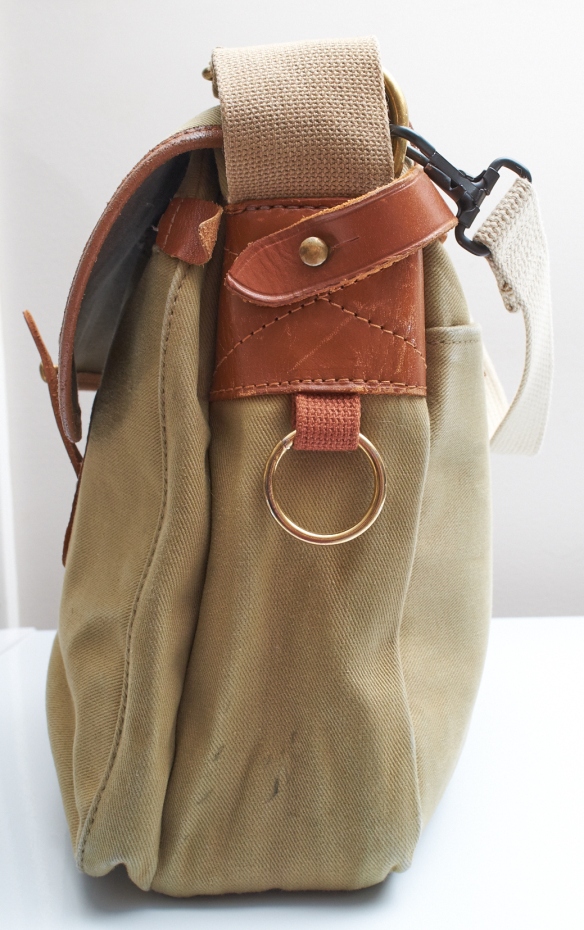
Right side view showing the Gelderburn’s fish net ring. Handy spot to attach one’s light meter carrying strap
It has two large pleated pockets at the front with zipper closures, a document pocket at the bag for carrying papers, and the main compartment has a zipper closure. There’s a brass ring to attach a fishing net, which happens to be a useful place to attach the carrying strap of a light meter.
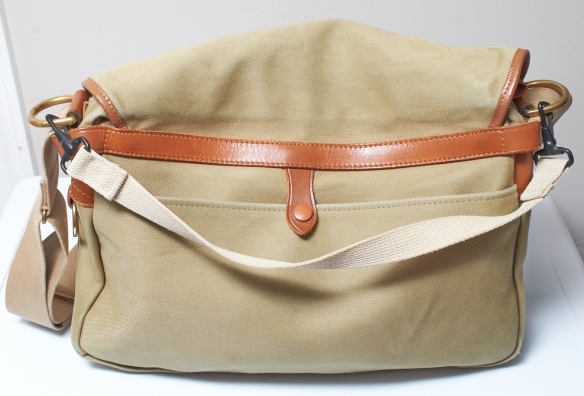
Document pocket with button closure on the back. I had a carry handle attached as a modification to the bag
There are two leather loops to carry a waist strap that’s included with the bag. The shoulder strap is adjustable.
The bags themselves are made from very thick, tough and long-lasting canvas, with leather trim. When I bought my Brady Gelderburn over a decade ago, the canvas came only in khaki color, with brown leather trim. Today, it’s available in black, and olive canvas too. While the khaki can keep one’s equipment inside the bag cooler in direct sunlight, a black or olive bag won’t look as dirty and as worn, after years of service.
http://www.bradybags.co.uk/shop/Shoulder-Bags/155/Gelderburn-/
Michael Palin used the Gelderburn in his famous travel TV series from the ‘90’s. While it was originally designed as a game and fishing bag, besides its additional use as a camera bag, it can easily be pressed into service as a travel bag. A testament to its versatility.
The Brady and Billingham lines are obviously from the same country and their bags have a similar design DNA. The Ariel looks like a precursor to the Billingham Hadley, and the Gelderburn looks like the ancestor to the Billingham Packington.
However, with the exception of their current, limited edition Kennet photo model, Brady bags are NOT camera bags. No internal padded walls or dividers. I’ve read that photojournalists of the ‘70’s would use magazines and newspapers as impromptu dividers, to separate their equipment within Brady bags. This always struck me as a rather dangerous way to take care of one’s working tools!
Mr. DiMarco had a better way of dividing his gear inside this non-camera specific bag’s main compartment. He told me that he would use Domke wraps (padded fabric squares that can be closed with Velcro, which are also available from other bag makers today) to wrap his lenses, and these would sit in the bottom of the bag.
For his spare Leica M bodies without lenses, Mr. DiMarco would place them in Crown Royal bags (yes, from the whiskey!!!). Over a decade ago, I still had multiple M bodies, so of course, wishing to following Mr. DiMarco’s advice to the letter, I went out and bought (and drank) three Crown Royal bottles in order to get their carry bags!
So all of this wrapped gear would have some minor protection from impact, and would sit randomly in the bottom half of the Gelderburn’s main compartment. Sitting on top of all this gear, Mr. DiMarco would have at least one, possibly two Leica M bodies with lens mounted, ready to shoot, without any wrapping.
This seems like a chaotic system, but choosing different colored wraps was a surprisingly easy way to find lenses quickly. And the fact that all this gear was stuffed into the bag without a padded insert with dividers, meant that the bag could be packed with a lot of gear. Everything was packed tightly, yet the wraps provided sufficient protection that my equipment was never damaged.
These days, I only own one Leica M, a battered but perfectly functioning M3 with a Zeiss ZM 28mm Biogon lens. I don’t use it that often, and if I did, the Gelderburn is far too large a bag for carrying a single Leica rangefinder by itself.
But I do own a complete Fuji X system, including two X-Pro1 bodies which have a remarkably similar form to the old Leica M. Today, the Brady Gelderburn can once again be packed in the same way Mr. DiMarco stored his Leica M system, using the similarly shaped and sized Fuji X system.
Here’s a picture of the Gelderburn, packed Mr. DiMarco style. I used an old Domke padded silo around an XF 60mm Macro, a long scarf is protecting a 17mm F mount lens with a Kipon shift X adaptor, and the two Velcro neoprene wraps are protecting an XF 10-24mm zoom and an X-Pro1 with an XF 18mm wide angle.
Ready to shoot and sitting on top of all of this, is my ancient Leica M3 with its Zeiss ZM 28mm Biogon and accessory 28mm Leitz viewfinder. Normally, the camera on top in the ready position would be another X-Pro1 with a Zeiss Touit 32mm f1.8 or the XF 18mm f2.0, but I needed that camera in order to shoot these pictures. In one of the front pockets is an old Minolta light meter and the other front pocket holds spare batteries and basic lens cleaning supplies.
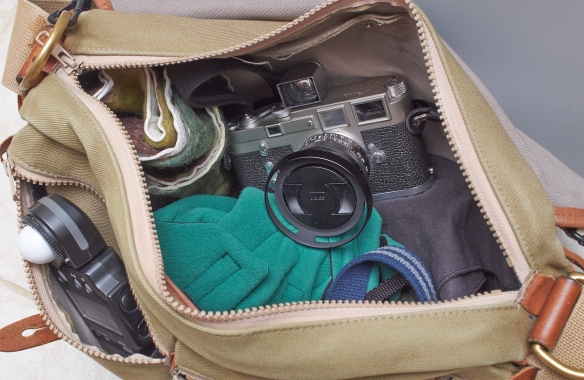
Fuji X-System: 4 lenses & an X-Pro1 body, all wrapped up. Sitting on top is an old Leica M3 with a Zeiss 28mm Biogon & Leitz 28mm bright line finder
So that’s two rangefinder form camera bodies, five lenses (two mounted on the camera bodies) plus a small selection of accessories in the front pockets. Plus there’s room to spare in all of the compartments. Not bad for an old fishing bag.
Note also how the main compartment’s opening is quite wide when placing items individually wrapped, rather than using a semi-rigid, aftermarket insert. It makes access easy to all of the gear. Yet when the bag is picked up or the strap is slung over a shoulder, the bag reverts to its skinny, 5″ depth. This is the advantage of a very soft bag without padded walls.
If the main compartment is zipped up and the flap is in place, it makes for excellent protection, keeping out dust, rain or snow out of the compartments. The flap is secured with two clog ball closures. These are very fast and completely silent to use.
The Gelderburn doesn’t have adjustable flap straps, like the Brady Ariel Trout or the Billingham Hadley Pro. On those smaller bags, adjustable flap straps are useful, if you sometimes stuff those bags to full capacity. In practice, this wasn’t an issue on the Gelderburn, as the bag is so much larger than an original or Pro Hadley, or Trout, that well before I could fill it to over-capacity, the bag would be too heavy for me to practically use.
Speaking of heavy loads, another valuable piece of advice that Mr. DiMarco gave me, was to use a Domke postal pad. I did install one when I carried a full Leica M system up until 2009 and it improved comfort significantly. A Fuji X system with the same number of lenses and bodies is noticeably lighter, however, and I rarely ever find the need to use the Domke postal pad anymore.
The bag didn’t have a secondary carry handle beyond the shoulder strap. For those who’ve ready my other camera bag reviews, you’ll know that for me, No Carry Handle = I Won’t Use the Bag.
If you look at pictures of the bag on Brady’s site, it looks like it has an accessory carry handle, but that’s actually a waist strap, that helps stabilize the bag while fishing. It isn’t meant to support the load of a camera system.
On my personal Brady Gelderburn, there are proper, weight-bearing brass rings that are correctly sewn in. Attached to them is an aftermarket hand carry strap, specifically made to bear the weight of a loaded camera bag.
When I ordered the bag, I had the retailer, who were also bridle leather experts, sew in two heavy-duty brass rings where the shoulder straps enter the bag on either side. I used a Domke canvas handle with its two spring clips. This allowed me to carry the bag with a handle and not just the shoulder strap. Very functional for pulling the bag out of cars, picking it up off the floor, and carrying in hand without the bag dragging on the ground (which can happen if the shoulder strap is used).
Over 12 years of frequent use, I can tell you, a Brady Gelderburn is almost as well built as a Billingham. It’s a solidly constructed bag for serious outdoor use, and has unquestioned durability.
With all that time of pressing the Gelderburn into service for which it wasn’t intended, I did learn a few things. Using padded wraps on my lenses and spare camera body was a pretty good solution for a bag that didn’t have its own dividers. But ultimately, I prefer today’s padded inserts with modular & removable walls or dividers.
A padded insert with dividers means I don’t have to individually wrap and then unwrap, my lenses and camera bodies. Those padded wraps means adequate protection for my gear, but it also means extra valuable seconds required to unwrap an item I need to get to. During a fast moving, photographic situation, a few seconds feel like an eternity.
I suppose some may ask, why not use the padded, modular insert from a bag like the Billingham Hadley Pro and just drop it into the Brady Gelderburn?
The reason is: the main compartment has a zippered closure. I’ve found that on slim, messenger or fishing bag style bags, zippered main compartments limit ease of access to one’s equipment. Unless that zippered top can be folded back like the design on Billingham’s Series 5 bags, it’s a hassle to access one’s gear with the insert in place.
Using Mr. DiMarco’s wrapping system with the zippers isn’t bad, because there’s no padded walls or lid that narrow the open space or get in the way.
When I’ve tried dropping in the Hadley Pro’s modular insert, the insert’s padded lid interferes with the zips, and the padded walls makes the already small opening even narrower. The top no longer yawns wide open, as it does when individually wrapped items are placed in the bag without padded walls.
Also, the Gelderburn’s carrying capacity drops significantly, by shoehorning in another manufacturer’s padded insert. Perhaps an insert with slimmer walls and no lid would work well with the Gelderburn.
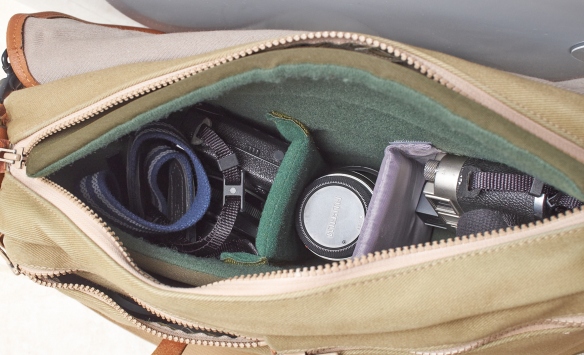
Not ideal: a padded, modular insert with a lid is shoe-horned into the Brady Gelderburn. Access isn’t great and capacity is reduced
These days, I still use the Gelderburn, but not as a dedicated camera system bag. If I’m out for a city walk all day and I want to carry additional clothes in anticipation of rain or a drop in temperature, the Gelderburn’s large capacity is perfect. I load my soft clothes into the bottom of the bag, and then an X or M camera with lens at the ready, sits on top of it. If I want to carry another lens, it gets wrapped so it doesn’t bump into the camera.
The other great use for this bag today is carrying my 13” Macbook Pro. The Gelderburn’s lack of padding isn’t a big disadvantage for me, as I have my Macbook wrapped in its own hard shell armor. The large, front pleated dual pockets has lots of room for the small brick cable charger and a mouse.
For dedicated photography use, I believe there are better solutions like the Filson Harvey Messenger and the Billingham Hadley Pro. Their photo-specific inserts with removable dividers and main openings without zips, make for fast access to equipment while providing good protection. Those inserts are designed with a zipper-less opening in mind, so access is easy and retrieval of gear is fast.
But a few decades ago, Brady bags were the go-to bag for international photojournalists, as they didn’t have the choice of camera system bags that we do today. Separating their equipment with magazines or folded newspapers, or better still, using padded wraps like Mr. DiMarco, made the Brady Gelderburn sufficiently functional as a camera bag for a working photojournalist.
It’s still a great choice today, if one is looking for a versatile bag that isn’t just about carrying camera gear. It can serve multiple roles for you: An overnight travel bag carrying a change of clothes plus a camera with a lens or two, or perhaps a laptop bag, and don’t forget, if you buy it with its snap-in, waterproof liner, it still makes a great fishing bag.
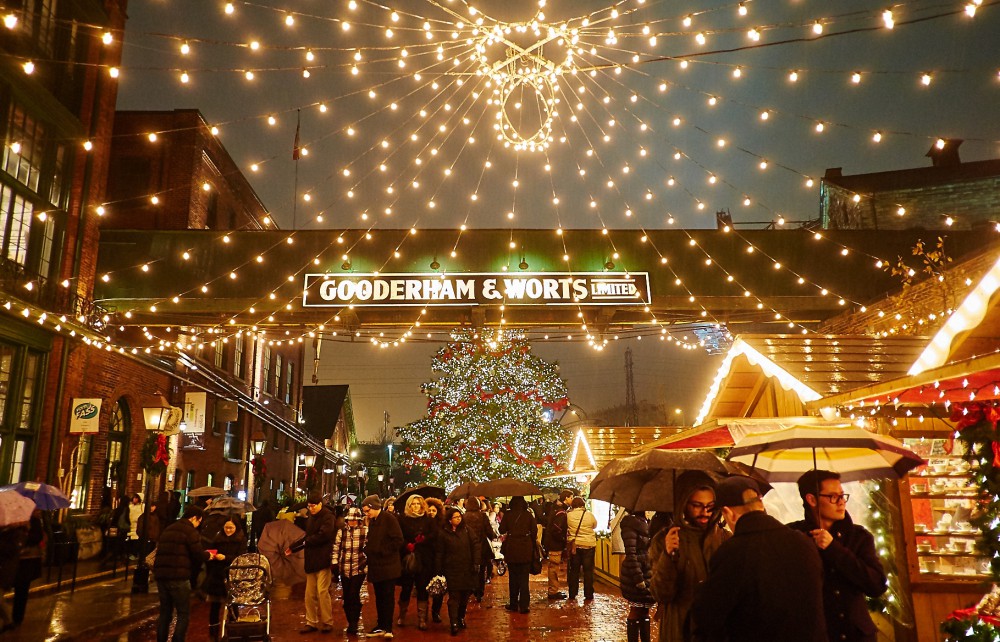
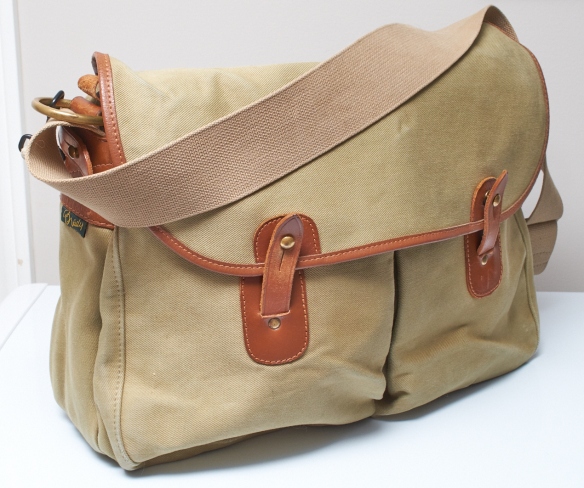


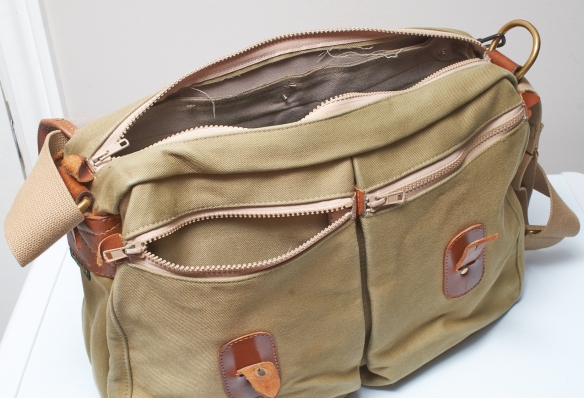
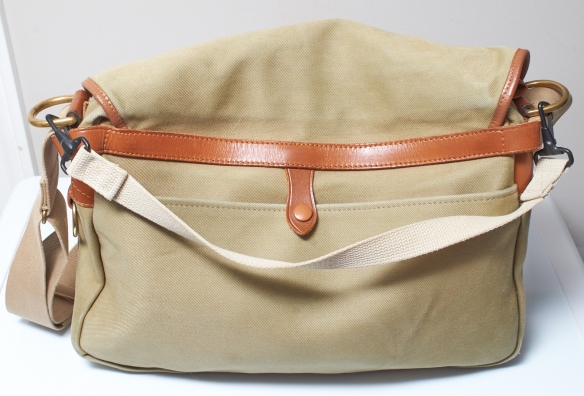

Pingback: Brady Gelderbun: The Grandfather of Modern Camera Bags - Japan Camera Hunter
Very nice piece.
I’m originally from the same part of the UK as Brady Bags and when I was younger, worked in a local graphic design agency who had Billingham as a client. When their camera bags came into the studio to be shot, I lusted after them, and then not long after that I discovered that the Brady bags were the forerunners and immediately switched my attention over to them.
There’s a few other companies making similar gear now, but the Brady stuff is the original and just as superb in quality as they’ve always been. It’s lovely to see them being written about like this.
Hello;
Thank you for the kind words about my article.
That’s very interesting you worked at the agency that did the design work for Billingham. They’ve always had beautiful catalogues, advertisements, etc.
Certainly, the Billingham bags are luxurious and very well made. On the other hand, I love the simplicity, versatility and elemental character of the Brady bags. While Billingham’s are certainly functional, they also look and feel luxurious. Brady bags are excellent in quality too, but there is a certain no-nonsense, “function above everything else” feeling about Brady products, that I like very much.
I used my Brady Gelderburn today. I needed it for a client meeting, and it made a neat, smart-looking laptop bag for my Macbook Pro. This evening, I’m heading out to a concert, so I’ll remove the Macbook Pro and drop in a small Fuji X camera with a single lens. Easy to multi-purpose the Brady.
Best regards, Marco
Hi again Marco,
I can’t take too much credit for the older Billingham work, as at the time I was fresh out of college and diligently doing as I was told by the good lady who ran the agency!
Any way, you’re quite right about the differences between Billingham and Brady. I believe that every country has its good offerings and its bad, and England is no exception. Both Billingham and Brady are great products, but the Brady bags seem to go hand in hand with the best of the unapologetically functional English stuff; things like Goodyear welted shoes from Northampton, or ancient Land Rovers. In my humble opinion of course.
They may not be glamorous, or luxurious, but they all do their job so very well, they’re all capable of continuing to do that job for so very long, and they all seem to improve with age.
It’s a shame that there’s not more stuff out there like that, but we can at least appreciate what there is.
All the best, I’ll be a regular viewer from now on.
Hello Expat Brit;
Goodyear welted shoes from Northhampton are a great example! I like how they can be re-soled repeatedly and as long as the uppers are kept supple with cream and wax, they will last indefinitely.
Thank you again for your very kind words, it means a lot to me. I’m very happy to that you’ll be a regular viewer. Feel free to make any suggestions to me about future subjects you might be interested in reading about.
Recently, for my daily photography work, I’ve been using both fishing/messenger style bags (like the Brady or Filson Harvey) for certain work, and then switch to a bigger, gadget-style bag like the Billingham 225 or 335 for certain types of jobs. I’ll likely write about that soon, and the difference in advantages/disadvantages, between these fundamentally different types of bags.
Best regards, Marco
BTW, my favourite business shoes with Goodyear welted soles are –
Alden, especially those with a cordovan shell upper
Allen-Edmonds, also with cordovan upper
GJ Cleverly – a chisel toe business slip-on in calfskin, and a couple of Oxfords
Have used the same Brady Gelderburn for camera/travel for 30+ years. Unfortunately now threadbare. Would like to find a replacement that would fall into “gently used” category. Would very much appreciate name/address of anyone willing to part with a Gelderburn
in above condition. Thank you.
Hello John;
I apologize for not getting back to you sooner – New Year’s celebrations have been busy here.
I’m glad to hear your Brady Gelderburn lasted over 30 years for photo and travel use. That’s amazing longevity for a canvas bag.
Here in Canada, most people don’t know of the Brady brand, and none of my photography friends own one. So unfortunately, I don’t have a source for you.
I do see some sales and free shipping offers on Brady bags from Sporting Lodge sometimes. I bought some waxed goods from them last year and they were reliable to purchase from. They might be worth checking out.
All the best, Marco
Used Brady Gelderburn bags on ebay.
Pingback: Brady Gelderburn 的光輝歲月 | Brady Bags Hong Kong
Pingback: The Glorious Time of Brady Gelderburn | Brady Bags Hong Kong
Great article. New Brady Gelderburn bags are available from http://www.smithscountrypursuits.co.uk